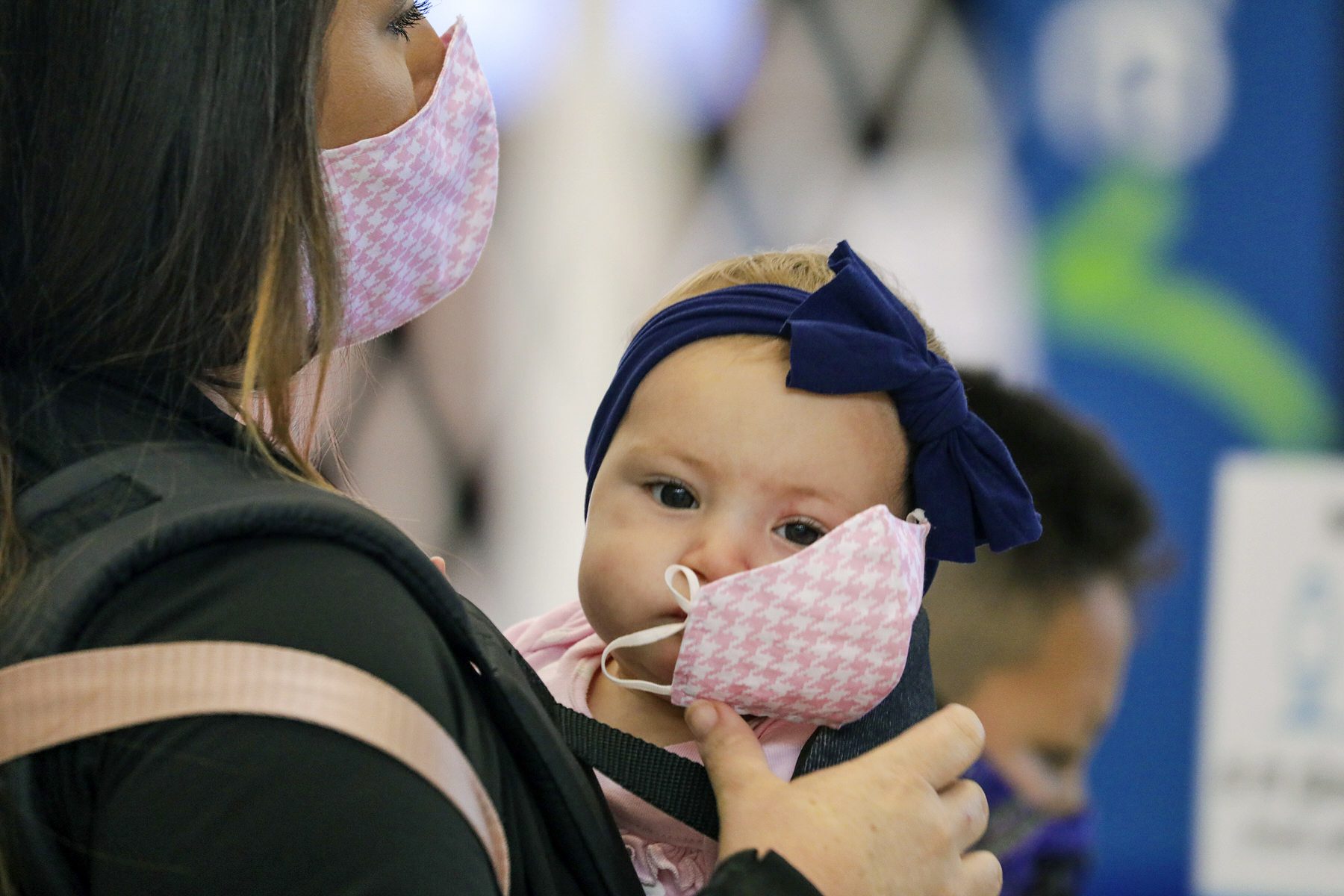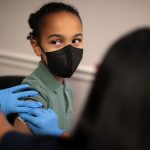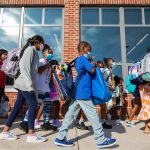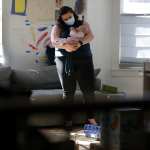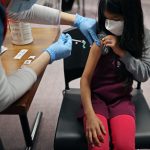As the Delta variant surges across the United States, parents continue to perform an ever-changing risk-benefit analysis to protect their kids. The situation is even more acute for parents with children under 12, who are currently not eligible for vaccination. But the parents perhaps facing some of the hardest questions — with the least number of answers — are those with children under the age of 2, who are too young to mask and yet require a high degree of adult supervision and care.
Dr. Anita Patel, a pediatric critical care physician at Children’s National Hospital in Washington, D.C., says risk analysis for COVID and life with a very young child isn’t just a hypothetical rooted in either her research or clinical work. It’s also a critical part of her daily decision-making: She gave birth to her now-16-month-old daughter during the early months of the pandemic, and was back at work two and a half months later.
Making things even trickier for parents of very young children, Patel told The 19th, is that “unfortunately, the really granular data” looking at COVID rates and outcomes for children 12 months and younger is just not there yet.
The 19th spoke with Patel and other experts to help parents of young children best understand the context around what is currently known, how things are changing in light of the Delta and emerging Lambda variants, and how to make informed choices about parenting in the pandemic.
What do we know right now about young children and their risk of COVID-19?
“Right now we’re flying the plane while we’re building it,” Dr. William Golden, the medical director of the newborn nursery at Johns Hopkins Hospital, told The 19th. While there has been lots of attention to the risks posed to school-age children, especially in light of varying mask mandates in different school districts in states, even more questions remain about what navigating COVID looks like right now for even younger kids — those too young to be in school and especially those under the age of 2, who are too young to mask.
“Children under 6 years of age are thought to be lower-risk for COVID generally, but we don’t know what Delta is now going to do,” Golden said of what we know about the demographic generally. “The issue of concern now is that we don’t know if the evidence says whether Delta creates more severe disease, but we are seeing more children currently presenting with infection. Children are being infected more with the Delta variant.”
And younger and younger children, historically not a significant part of the COVID case count, are increasingly becoming infected and, in turn, hospitalized.
That said, Patel explained, “what we believe right now and have believed since the beginning of the pandemic and is even more true now with Delta is that kids less than 1-year old are always believed to be more at risk of developing COVID because of their immature immune system and the fact that they have smaller airways because they have smaller lungs.” Per data from the Centers for Disease Control (CDC), the highest number of hospitalizations and ICU admissions among all COVID cases for children occurred in kids under 4the 0-4 demographic between March and December of 2020.
But, Patel said, “context is important,” which is why it’s also key to keep in mind that these same two factors also set kids in this age demographic up to have more severe breathing issues as the result of any kind of respiratory virus. (She points to the way that pediatric ICUs are currently overwhelmed with RSV cases as further proof.) “Are kids less than one at more risk of COVID? Yes. But they’re also more at risk of being sick with RSV, rhinoviruses, and many other kinds of viruses we’ve always known about,” said Patel said.
When it comes to understanding the risks of COVID for infants and toddlers, it’s important to know that infants are more susceptible to severe outcomes when it comes to all viruses, including COVID, because their immune systems are not yet fully mature, said Dr. Mark Sawyer, an infectious disease specialist at Rady Children’s Hospital in San Diego. That said, “we haven’t seen that many infants hospitalized with COVID,” Sawyer said. “I don’t know if that’s because they’re not getting sick with the virus, or if they’re not getting infected because they’re not out and about in the community.”
In general, Sawyer said, parents of infants are always advised to be “careful about exposing their babies to strangers, period. COVID doesn’t change the formula all that much for infants versus how we respond to other infectious diseases.”
When talking about infectious disease in infants generally, Sawyer explained that there is a “break point at three months of age and above” when it comes to the maturation of a child’s immune system. After three months of age, though, you can think of your baby as having slightly less risk of serious infection because a doctor would be more likely to be able to diagnose and treat them sooner, and because their immune system has had at least some time to start to build up.
“We’re just not sure what the issues are with infection” when it comes to Delta and small children, said Golden. “We know that COVID has been low-risk in newborns in the past, but we want to make sure we have a handle on Delta before we say that it’s not problematic for newborns.”
How are COVID case counts changing in young children?
To have some context with some numbers, Patel pointed to the existing data sets around children under the age of 4, a demographic that currently represents about 6 percent of the total population in the United States and, before Delta surged, about 2.2 percent of all reported COVID cases. The under-4 demographic has consistently seen the fewest number of cases for the bulk of the pandemic. These numbers tell an important story, Patel said, because compared to COVID case rates in other age demographics, the percentage of cases is much lower than the percentage of total population. (Usually, these two numbers track hand-in-hand.) “All of this is to say that kids less than 4 are not at an increased risk of getting COVID or being hospitalized,” Patel said.
As of the first week of August, children now represent approximately 14 percent of all COVID cases in the United States, a figure that accounts for all minors under the age of 18. It’s a big leap for where kids have stood when it comes to infection from the pandemic’s start last spring.
There have been 175 deaths in the 0 to 4 age demographic since the pandemic started in America, the vast majority of which have occurred in young children with preexisting conditions, said Patel. Right now, that number is so small compared to the national mortality rates that it still statistically registers at 0 percent, Patel explained. While numbers do seem to be increasing with the Delta variant, Patel still stressed that it’s important to keep in mind that Delta isn’t attacking kids specifically, it’s just much more transmissible.
What are the concerns when it comes to young kids and long COVID?
“The only thing that makes COVID more unique compared to other viruses are the emerging reports of long COVID,” Patel said. While long COVID is rare in young children and seems to resolve within five months, it’s fair for parents to be concerned. “Five months for kids less than one is a very long time,” acknowledged Patel said, “but the literature doesn’t indicate that this is a pervasive problem” in this age demographic.
But long COVID is “so difficult” to understand from a research standpoint in young kids because the symptoms are often non-specific: inattention, headaches, persistent cold symptoms, insomnia, muscle pain — the kinds of things parents of small children either commonly see separate from COVID or have no real means of assessing in a pre-verbal child.
“Other than cold symptoms, how many 2-year-olds are saying, ‘I’m having a hard time concentrating’ or ‘I think I have brain fog,’” Patel said. She added that the only studies done so far on long COVID in children have been retrospective ones where groups of kids with COVID have been selectively interviewed afterwards.
Can you safely bring your kid who can’t wear a mask to the grocery store?
“If you don’t have to bring your infant to the grocery store, you shouldn’t,” Sawyer said. “But if your circumstances are such that there is no other option, the risk is still pretty low if you can minimize exposures to strangers.”
Patel is firm about this in her personal life. “My daughter has never been to a grocery store and she’s 16 months old,” Patel said. “We made the decision early on that we wouldn’t take her inside somewhere unless we absolutely had to. I have the luxury of having a husband; I am not a single parent and didn’t have to make that decision about bringing her into a grocery store with me. If you have the options and the resources to not take your kid to a grocery store right now, I would suggest you not take them.”
Because children under the age of 2 cannot wear masks, Patel recommended keeping them out of enclosed, public indoor spaces as much as possible — with the caveat that depending on where you live, there might be a little more leeway. In a city or state with an indoor mask mandate you’re probably better off. In a county with a particularly low case count right now? Same.
But, as Sawyer noted: “If you live in a place with a Delta outbreak, you should revert to whatever you did during the peak COVID era.”
Is it safe to send your child to daycare right now?
Despite her own reservations about letting her daughter into places like the grocery store, Patel ultimately decided to send her to daycare. She noted that while this was a decision she made before the current Delta surge, she also hasn’t pulled her daughter out of daycare now, even since Delta has been on the rise.
But Patel did recommend asking a number of questions to help assess the relative safety of a given facility. From her own experience, her “first and most important question” to a facility is how long they have been open for during the pandemic. The answer parents get back will help them best assess whether a facility “knows how to navigate every changing guidelines that’s been in place during the pandemic.”
The immediate follow-up question she suggested asking is how facilities respond when a child in their care or one of those child’s immediate family members contracts COVID.
“Particularly if a child in a classroom is positive with COVID, the only answer should be immediately shutting down that classroom, having everyone tested, and implementing a 10-day quarantine,” Patel said. “I know the idea of a 10-day quarantine is impossible as a parent, but it’s the nature of the game right now in a pandemic and really the only answer a daycare should be giving you.”
She also recommended asking if teachers are required to wear masks regardless of vaccination status as a way to “take the temperature of how cautious the daycare is being.” Next up would be asking about vaccination rates in teachers, and asking if you can request that your child be placed in a classroom with a vaccinated teacher if they do not have a 100 percent vaccination rate.
“How I phrased this is, ‘I know this is personal health information for teachers, but I would love to know for my own wellbeing if my child’s teacher is vaccinated,’” Patel said. “They don’t technically need to tell you, but I think it’s worth asking.”
If you can’t get answers to these questions, Patel suggested pivoting to more general questions about regular COVID testing in the facility, saying that in areas with a moderate to high risk during the Delta surge, unvaccinated teachers should be tested every two to three days.
It’s also important to look for a facility that does not let individual classrooms of kids mix together, thus allowing a school to shut down only one classroom at a time should there be a positive test or known exposure in a class. At her own child’s daycare, the school also requires that several parents in each class be randomly tested every two weeks with their results then shared with the school as a means of taking a community-based approach to being mindful of asymptomatic infections.
These measures don’t always come cheap, and that means for many families daycare is even more out of reach than it was before. This leaves families in the same bind they were in last year, with children staying home and one caregiver — often the mother — scaling back at work or giving up a job.
“I think going to preschool or daycare still is reasonable right now,” says Sawyer said., “And hopefully those places are taking precautions to minimize the risk of transmission.”
Golden also said that if your child is sick in any way, or you hear about a child in your child’s daycare class being sick, it is important to keep your child home regardless of facility policy. And if your child has any COVID symptoms — especially cough, runny nose or fever — it’s important to have them evaluated for a potential COVID infection right away. “That’s the best advice I can give at this point.”
Should you travel with your young child on a plane?
“The honest truth is that we are seeing that people who are traveling right now are disproportionately getting COVID infections,” Patel said. “If travel is nonessential — and I hate to use the word ‘essential,’ because some things really do feel essential — but if you can miss it and it won’t negatively impact the mental health of your family to a large degree, my recommendation would be to avoid air travel.” This is especially true if those travel plans include bringing a child too young to mask with you.
Sawyer recommends that if you are traveling outside of your immediate community, ensuring that everyone in your family who is eligible for vaccination is fully vaccinated could help prevent severe outcomes for the family as a whole, especially for infants. “Take every precaution you can take short of putting a mask on a child under the age of 2.”
Patel said that right now, she is not personally comfortable getting on a plane with her own daughter. “She can’t wear a mask, and I don’t have data because Delta is too new, but I can say that from the reports we see emerging, we are seeing a disproportionate number of cases linked to travel.”
Golden added that if you as an adult are getting on a plane right now, it’s imperative that you wear a mask. Fortunately, though, because of the way that air circulation works on planes, the plane itself is another form of risk reduction. “I can’t say the risk is zero, but trying your best to minimize that risk is important.”
Should you be concerned, if you are vaccinated, about your risk of breakthrough infection if you have a young child?
Though there are many reports about breakthrough cases — or, those cases where fully vaccinated people are still contracting COVID infections — right now, Patel said the numbers are currently still in the single digits in each state and represent a “tiny” proportion of all COVID cases nationally right now. “I don’t think they are the primary culprit of transmission to kids. But it is a possibility though.”
Delta has changed what was previously understood about a vaccinated person’s ability to spread COVID. Whereas pre-Delta, a vaccinated person was largely understood to be unable to carry a large enough viral load to transmit the virus, Patel said “this doesn’t hold true anymore with the Delta variant” since an infected person carries the same amount of viral load, whether they are vaccinated or not.
So could parents go on an adults-only trip and safely come back to their kids after? Maybe. When it comes to a vaccinated adult contracting COVID and then passing it along to their child, Patel said “it’s a possibility. It’s a low possibility. But it’s a possibility.”
Sawyer also stressed that it is known that vaccinated people can get Delta and transmit it, so no interaction between all-vaccinated adults is a zero-risk situation. “If you know something about the other adults you are interacting with and know they are taking the same precautions you are, the odds that you will get [COVID] and give it to your child are all pretty low.”
